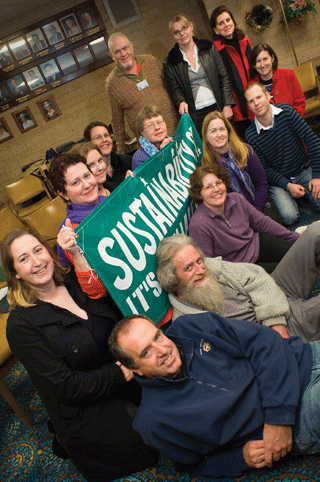
|
Published:
Social change movements
The 21st century has seen a proliferation of new social change movements driven by grassroots community activism. On the issue of climate change, for example, scores of community-based groups have formed in Australia over the past few years to provide forums for discussion, local action and public campaigns. Behind these movements is a growing body of ‘concerned citizens’ united by a sense of urgency, a vision of a better world and mapping a pathway for getting there.
When the modern environmental movement came into existence in the 1960s, people were optimistic that environmental problems could be solved. In a symbolic cover story in Newsweek on 26 January 1970, both the President of the United States and the head of General Motors were prepared to commit themselves to the task.
Now, almost 40 years later, despite the gains in some areas such as ozone depletion and urban air and water quality in developed nations, people appear more pessimistic about our environmental prospects. We can see now that we were naïve about the gulf between the magnitude of the task and the scale of our response. For all the efforts governments are making, the gap between what we are doing and what we now know we need to do continues to widen.
Closing this ‘political reality gap’ will mean paying more attention to the social aspects of environmental problems. Of the ‘triple bottom line’ of sustainability – the environment, economy and society – the political focus has been firmly on the economic and environmental, on trying to balance and reconcile the needs for both economic growth and sustainable resource use.
Social movements are, fundamentally, about changing people’s attitudes and behaviour, and so allowing – even forcing – governments to do more.
Over the past decade, researchers have revealed that about a quarter of Americans and Europeans are ‘cultural creatives’, who have made a comprehensive shift in their worldview, values and way of life. They are disenchanted with materialism, greed, status displays and glaring social inequalities. Instead, they are placing emphasis in their lives on relationships, communities, spirituality, nature and the environment, and real ecological sustainability.
According to the researchers, cultural creatives represent a coalescence of social movements that are not just concerned with influencing government but with reframing issues in a way that changes how people understand the world.
Other surveys have shown that about a quarter of Australians and Britons are ‘downshifters’: people aged 30–59 who, in the past 10 years, have voluntarily made a long-term change in their lifestyle that has resulted in their earning less money. The means included cutting back work hours, taking a lower-paid job, stopping work and changing careers.
Linked to this development is the global emergence of what American social activist Paul Hawken describes as the largest social movement in history.1
The movement is not hierarchical, nor does it have leaders and ideologies; there is no manifesto or doctrine. Hawken says it is not merely a network, but a complex, self-organising system, made up of over one million organisations worldwide. Its roots lie in environmental, social justice and indigenous movements – research institutes, community development agencies, village- and citizen-based organisations, corporations, networks, faith-based groups, trusts and foundations.
Is this hype or hope? Perhaps both. Some question whether all those who are included among cultural creatives or in Hawken’s coalition are really fighting for a global, social transformation, rather than being just self-focused, ‘New Age’ enthusiasts or local, single-issue campaigners. At the same time, there is something in the notion of a ‘wired’ global movement, connected by the internet and other communications technologies, that is challenging the status quo.
For example, WiserEarth,2 inspired by Hawken’s work, is an online community space connecting the people, non-profit organisations and businesses working toward a just and sustainable world. GetUp3 in Australia and Avaaz4 internationally are using new technologies to mobilise public opinion on political issues.
This movement could grow ever larger and faster as global events give it impetus.
It really might change the world.
Richard Eckersley is a social analyst whose research explores issues around progress and well-being. He has held senior positions with CSIRO, the Commission for the Future and the Australian Government, and is currently a director of Australia 21 (www.australia21.org.au), a non-profit organisation that researches national challenges such as climate change, land and water use, realising young Australians’ potential and the way we relate to neighbouring countries.
More information:
Eckersley R (2008) Nihilism, fundamentalism, or activism: three responses to fears of the Apocalypse. The Futurist 42(1), 35–39.
Eckersley R (2004) A new world view struggles to emerge. The Futurist 38(5), 20–24.
Hawken P (2007) Blessed Unrest. Viking, New York. www.blessedunrest.com
Ray P and Anderson SR (2000) The Cultural Creatives. Harmony Books, New York. <www.culturalcreatives.org>
1 See ECOS 145, page 8: www.ecosmagazine.com/?act=view_file&file_id=EC145p8.pdf
2 www.wiserearth.org
3 www.getup.org.au
4 www.avaaz.org




